Have you been suffering from excruciating pain and limited mobility caused by a shoulder dislocation? Everyday activities like reaching for an object or lifting your arm become agonising challenges, impacting your quality of life. But fear not, relief is within reach. Dr Stuart Kirkham, a highly skilled and experienced orthopaedic surgeon at the Sydney Orthopaedic Surgeon Clinic, is here to guide you back to a pain-free life.
With over 25 years of expertise in the field of orthopaedics, Dr Kirkham is a trusted expert when it comes to shoulder dislocations. His commitment to patient care and relentless pursuit of excellence have earned him a stellar reputation among patients and peers alike. When you entrust your shoulder health to Dr Kirkham, you can be confident that you’re in the hands of a true professional who will go above and beyond to provide you with the best possible care.
Don’t let shoulder dislocations hold you back any longer. Take the first step towards regaining your freedom of movement and a life without pain. Schedule a consultation with Dr Stuart Kirkham at the Sydney Orthopaedic Surgeon Clinic. Together, you’ll work towards finding the best solution for your unique situation. Don’t wait any longer—reach out to Dr Kirkham today and take that crucial step towards a pain-free future.
Anatomy of the Shoulder
The shoulder joint is a very intricate structure that allows for a wide range of motion, making it one of the most mobile joints in the body. It is composed of several key components, with each playing a vital role in the joint’s overall function. The bones of the shoulder include the humerus (upper arm bone), scapula (shoulder blade), and clavicle (collarbone). These bones work together to form the shoulder socket, known as the glenoid, where the head of the humerus fits snugly.
Supporting the bones is a network of muscles, ligaments, and tendons that provide stability and facilitate movement. The rotator cuff, a group of four muscles (supraspinatus, infraspinatus, teres minor, and subscapularis), plays a crucial role in the shoulder’s function. These muscles work in harmony to keep the humerus centred within the glenoid and provide strength and control during various movements.
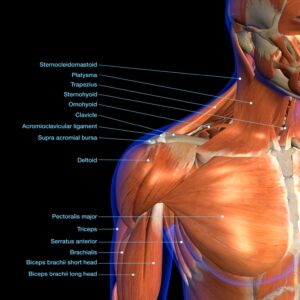
Ligaments are fibrous bands that connect bone to bone, providing additional stability to the joint. The main ligaments in the shoulder include the glenohumeral ligaments, which reinforce the front, back, and bottom of the joint, and the coracoclavicular ligaments, which stabilise the collarbone and shoulder blade. Tendons, on the other hand, connect muscles to bones, allowing for the transfer of force during muscle contractions.
The complexity of the shoulder joint also makes it more susceptible to injury. Its wide range of motion leaves it vulnerable to various conditions, including shoulder dislocations. The shallow nature of the glenoid socket and the relatively large size of the humeral head contribute to the joint’s instability. High-impact trauma, sudden or unexpected falls, sports injuries and repetitive stress can lead to the humerus being forced out of its socket, resulting in a shoulder dislocation.
Without a healthy and intact shoulder joint, everyday tasks become challenging and painful. Shoulder dislocations, in particular, disrupt the normal alignment of the joint, causing immense discomfort and compromising its stability. When you understand the intricacies of the shoulder and how important its various components are to our everyday lives, we recognise the importance of seeking Dr Kirkham’s expert care to treat shoulder dislocations and restore the joint to optimal function.
Causes and Risk Factors of Shoulder Dislocations
Shoulder dislocations can occur as a result of several causes, and they often involve traumatic incidents or sports-related injuries. The most common cause of shoulder dislocations is a direct blow or fall onto an outstretched arm, leading to the humeral head popping out of the socket. This can happen during activities such as contact sports, falls from heights, or motor vehicle accidents. Sports that involve repetitive overhead motions, like swimming, tennis, or throwing sports, can also contribute to the risk of dislocations.
Several risk factors increase the likelihood of experiencing a shoulder dislocation. Age plays a role, as individuals under the age of 30 are more prone to dislocations due to greater joint laxity and participation in high-impact activities. Additionally, men tend to have a higher incidence of shoulder dislocations compared to women.

Occupations or hobbies that involve heavy lifting, overhead movements, or repetitive stress on the shoulder joint can increase the risk of dislocations. These occupations can include construction work, manual labour, or professions that require frequent arm movements.
The structure of the shoulder joint itself contributes to the risks associated with dislocations. The shallow socket of the scapula allows for extensive mobility but reduces stability. This design makes the shoulder joint more vulnerable to dislocations, especially when subjected to sudden or forceful movements. The surrounding ligaments and tendons play a crucial role in maintaining stability, but they can become stretched or weakened over time, increasing the risk of dislocations.

Fortunately, Dr Stuart Kirkham has an intimate understanding of the complexities of shoulder dislocations and the impact they can have on daily life. With his specialist experience and expertise, he can accurately diagnose and treat various forms of shoulder dislocations.
By identifying any underlying causes and assessing individual risk factors, Dr Kirkham provides personalised guidance to help patients avoid worsening symptoms and prevent further damage. Whether it’s addressing traumatic injuries or managing risks associated with specific occupations or activities, Dr Kirkham’s comprehensive approach ensures that patients receive tailored care to regain shoulder stability and functionality.
Symptoms and Identification of Shoulder Dislocations
A dislocated shoulder can cause a range of symptoms that can be both alarming and debilitating. The most common symptom is intense pain in the shoulder joint, which may radiate down the arm. The affected shoulder may appear visibly deformed or out of place, and there may be swelling or bruising around the joint. Additionally, individuals often experience a sense of instability or looseness in the shoulder, making it difficult to move or bear weight on the affected arm. Reduced range of motion, accompanied by weakness, can further hinder daily activities.
Visual cues can help identify a dislocated shoulder. The dislocated shoulder may appear flattened or squared off, with a prominent bump or bulge in the shoulder area. The affected arm may hang slightly lower than the unaffected arm, and there may be an obvious asymmetry when comparing the two shoulders. These visual signs, coupled with the presence of intense pain and limited mobility, strongly indicate a potential shoulder dislocation.
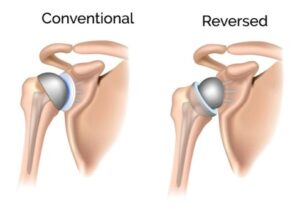
Recognising the importance of immediate medical attention is crucial when dealing with a shoulder dislocation. Seeking prompt medical care is essential for several reasons. First and foremost, a healthcare professional, such as Dr Stuart Kirkham at the Sydney Orthopaedic Surgeon Clinic, can accurately diagnose the dislocation and ensure proper treatment. Attempting to manipulate the shoulder joint back into place without proper knowledge and technique can lead to further injury or complications. Delaying treatment can also result in more severe pain, increase the risk of additional damage, and prolong the recovery process.
If you have been experiencing persistent shoulder pain, weakness, limited range of motion, or difficulty with everyday activities, it is highly recommended to consult Dr Stuart Kirkham. His vast medical expertise, personalised advice, and tailored treatment plans can help deliver the best possible outcome and improve your quality of life. Don’t let a dislocated shoulder hold you back any longer—seeking immediate medical attention is the first step towards a swift and successful recovery.
Diagnosis and Imaging of Shoulder Dislocations
Diagnosing a shoulder dislocation involves a comprehensive process that includes a physical examination and analysis of a patient’s medical history. During the physical examination, Dr Kirkham will assess the shoulder joint for any visible deformities, swelling and tenderness, and he’ll assess the patient’s range of motion. He may also perform specific tests, such as the apprehension test or the relocation test, to evaluate the stability of the joint and determine the likelihood of dislocation.
To confirm the diagnosis and evaluate the extent of the injury, various imaging techniques may be used. X-rays are often the first imaging modality employed as they can reveal bone fractures or displacements, providing initial evidence of dislocation. However, X-rays alone may not always provide a complete picture of the soft tissues surrounding the shoulder joint.
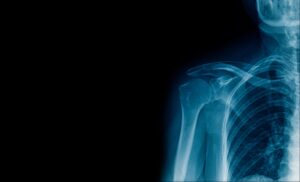
In cases where further information is needed, additional imaging techniques such as MRI scans or CT scans may be recommended. An MRI provides detailed images of the soft tissues, including the ligaments, tendons, and muscles, allowing for a more comprehensive assessment of any tears or damage. CT scans, on the other hand, provide cross-sectional images of the shoulder, helping to evaluate complex fractures or dislocations.
Dr Kirkham often utilises these imaging methods to ensure an accurate diagnosis and ensure no other damage has been sustained. By combining the findings from the physical examination, patient history, and imaging results, he can obtain a comprehensive understanding of the shoulder condition, ensuring an appropriate treatment plan is tailored to each individual patient’s circumstances.
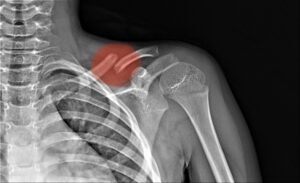
If you’re concerned that you may have been experiencing the symptoms of a shoulder dislocation or if you have a family history of these conditions, it’s crucial to seek expert medical advice for a thorough diagnosis. Dr Kirkham and the team at the Sydney Orthopaedic Surgeon Clinic have extensive experience in diagnosing and treating shoulder dislocations. By seeking their specialised care and advice, kickstarted by a thorough diagnosis, you can set yourself on the road to recovery. Don’t hesitate to contact our friendly team to schedule a consultation and receive the personalised advice and treatment you deserve.
Treatment Options for Shoulder Dislocations
Treating a shoulder dislocation must be done on an individual basis, ensuring the appropriate treatment is provided based on the level of damage the injury has caused and the individual circumstances unique to the patient.
Non-surgical treatments are often the first line of approach. Closed reduction, a procedure performed under anaesthesia, involves manipulating the dislocated shoulder joint back into its proper position. Following reduction, immobilisation through the use of slings or braces may be recommended to allow the joint to heal and regain stability.
Physical therapy can also play a crucial role in the non-surgical treatment of shoulder dislocations. Targeted exercises and physical therapy are essential in helping the patient restore strength, flexibility, and range of motion, and this promotes a full recovery while reducing the risk of future dislocations.
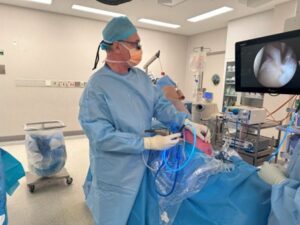
In cases where non-surgical treatments prove inadequate or the dislocation is severe, surgical intervention may be necessary. Open reduction involves a surgical procedure to realign the dislocated joint and repair any damaged structures. This approach is typically employed when there are complex fractures or extensive soft tissue injuries.
Arthroscopic surgery, a minimally invasive technique, involves using small incisions and specialised instruments to visualise and repair the shoulder joint. It is often preferred for less severe dislocations or cases where there are associated injuries that can be addressed arthroscopically. The choice between surgical options is determined by the severity of the dislocation, the presence of associated injuries, and the patient’s individual circumstances.
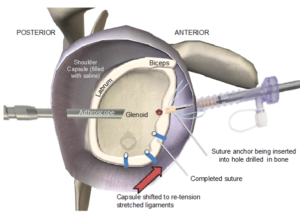
Effective pain management is a crucial component of shoulder dislocation treatment. Pain medications, both over-the-counter and prescription, may be prescribed to alleviate discomfort during the recovery process. Non-steroidal anti-inflammatory drugs (NSAIDs) can help reduce inflammation, while stronger pain medications may be necessary for more severe cases. Additionally, local anaesthesia or nerve blocks may be utilised during surgical procedures to ensure patient comfort.
Whether through non-surgical methods or surgical intervention, Dr Kirkham and the team at the Sydney Orthopaedic Surgeon Clinic are dedicated to providing personalised treatment options for shoulder dislocations. By considering the severity of the dislocation, associated injuries, and individual patient factors, they ensure that each patient receives the most appropriate and effective treatment to restore shoulder stability, and function, and alleviate pain.
Prevention and Aftercare for Shoulder Dislocations
To actively prevent shoulder dislocations from occurring, individuals may adopt a range of preventative strategies and habits. Regular exercise and strengthening of the muscles around the shoulder joint are important parts of this process, as these activities will enhance stability in the shoulders and reduce the risk of dislocations. Focus on exercises that target the rotator cuff muscles, such as external rotations, shoulder presses, and rows. Additionally, using proper techniques and protective gear during sports or physical activities, especially those involving overhead movements or contact, can help prevent injuries that may lead to dislocations.
Adhering to aftercare instructions is also crucial for a successful recovery and to minimise the risk of future dislocations. It is essential to follow any prescribed medications, such as pain relievers or anti-inflammatory drugs, as instructed by your healthcare provider. Resting the shoulder and avoiding activities that may strain or stress the joint is important during the initial healing phase.

Attending follow-up appointments and participating in rehabilitation programs, including physical therapy, is key to restoring strength, flexibility, and range of motion in the shoulder. Physical therapy not only aids in recovery but also plays a significant role in preventing future dislocations by improving the overall stability of the joint.
At the Sydney Orthopaedic Surgeon Clinic, Dr Kirkham and his team provide comprehensive guidance on prevention and aftercare for shoulder dislocations. By implementing preventive measures and following the prescribed aftercare instructions, patients can significantly reduce the risk of recurrent dislocations and promote long-term shoulder health.
Through personalised physical therapy programs, patients are equipped with the tools and exercises necessary to maintain shoulder stability, prevent muscle imbalances, and minimise the chances of future dislocations. By taking an active role in their recovery and adhering to the recommended preventive strategies, individuals can enjoy a life free from the limitations and pain of shoulder dislocations.
The Recovery Process for Shoulder Dislocations
The recovery process following a shoulder dislocation can vary depending on individual circumstances, the severity of the dislocation, and the chosen treatment approach. While each patient’s journey is unique, there is a general timeline to consider. Initially, the focus is on managing pain and inflammation, which can last for several weeks. During this time, the shoulder may be immobilised with a sling or brace to allow for healing.
As the healing progresses, typically within 6-8 weeks, the emphasis shifts to regaining range of motion and strength. Physical therapy plays a crucial role in this phase, with tailored exercises and techniques designed to restore shoulder function. The timeline for achieving full recovery can vary significantly, with the duration being influenced by individual factors such as age, overall health, and adherence to the rehabilitation program.

Patient involvement and cooperation are key factors in a successful recovery from a shoulder dislocation. Active participation in the prescribed exercises, both during physical therapy sessions and at home, is essential for restoring strength and flexibility. Patients must follow their healthcare provider’s instructions regarding activity restrictions, proper lifting techniques, and lifestyle modifications to avoid re-injury. Communication with the healthcare team is also crucial, as any concerns or changes in symptoms should be promptly addressed.
Throughout the recovery process, Dr Kirkham provides each of his patients with support specific to their situation, ensuring they receive the best possible standard of care. He closely monitors their progress and adjusts the treatment plan as needed to guide his patients through the various stages of recovery while addressing any questions or concerns that may arise. With his expertise and compassionate approach, Dr Kirkham strives to empower patients, enabling them to actively participate in their recovery journey and achieve the best possible outcome. Get in touch with Dr Kirkham today for personalised shoulder pain treatment in Sydney today.
Possible Complications for Shoulder Dislocations
While shoulder dislocations can be successfully treated, it’s important to be aware of potential complications that can arise during the healing process. Chronic instability is a common complication of shoulder dislocations, where the joint becomes prone to repeated dislocations. Dr Kirkham addresses this risk by thoroughly assessing the individual’s condition and tailoring the treatment plan to promote stability and prevent future dislocations. Surgical interventions, such as open reduction or arthroscopic surgery, may be recommended to repair damaged structures and enhance joint stability.
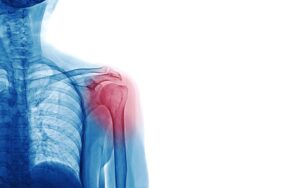
Nerve or blood vessel damage is another potential complication of shoulder dislocations. Dislocation can put pressure on nearby nerves or blood vessels, leading to numbness, tingling, weakness, or even circulation problems. Dr Kirkham minimises the risk of such complications by employing meticulous surgical techniques and closely monitoring patients for any signs of nerve or vascular compromise. Timely intervention and appropriate management, such as physical therapy and rehabilitative exercises, help restore nerve function and minimise long-term complications.
 Complications related to treatment can include infection and poor reactions to anaesthesia. Dr Kirkham follows stringent infection control protocols to minimise the risk of post-operative infections.
Complications related to treatment can include infection and poor reactions to anaesthesia. Dr Kirkham follows stringent infection control protocols to minimise the risk of post-operative infections.
He employs strict sterilisation techniques, prescribes appropriate antibiotics when necessary, and closely monitors patients for any signs of infection. Prior to any surgical procedure, Dr Kirkham thoroughly evaluates the patient’s medical history and conducts comprehensive pre-operative assessments to minimise the risk of poor reactions to anaesthesia. This is administered by qualified professionals who closely monitor patients throughout the procedure to ensure their safety and well-being.
While complications may arise, you can rest assured that in Dr Kirkham’s capable hands, every precaution will be taken to ensure you don’t encounter any of these problematic disruptions to recovery.
With decades of experience, great attention to detail and a strong commitment to every patient, Dr Kirkham has an exceptional history of restoring his patients to full health. With his ongoing monitoring and support, you too can join his long list of satisfied patients. Don’t let a shoulder dislocation and its associated pain influence your life anymore. Reach out to us and book a consultation for an expert dislocated shoulder surgery today.
Are You Concerned About Shoulder Dislocations?
If you find yourself concerned about the possibility of experiencing a shoulder dislocation, it’s crucial to seek expert advice and guidance. Don’t let the fear or uncertainty hold you back from taking action. Dr Stuart Kirkham and his team at the Sydney Orthopaedic Surgeon Clinic are here to help. By scheduling a consultation with Dr Kirkham, you can have your concerns addressed and receive a thorough assessment of your risk factors.
Dr Kirkham’s expertise allows him to evaluate your individual circumstances, such as your medical history, lifestyle, and any specific activities or sports you engage in, to determine your risk of shoulder dislocations. Based on this assessment, he can provide preventive measures and recommendations tailored to your unique situation. These may include exercises to strengthen the shoulder muscles, advice on proper body mechanics and lifting techniques, or guidance on using protective gear during sports or physically demanding activities.

The Sydney Orthopaedic Surgeon Clinic offers a range of services to address shoulder dislocations and related conditions. Dr Kirkham and his team provide comprehensive diagnosis, treatment, and rehabilitation options to help patients regain shoulder stability, reduce pain, and restore function. With their expertise in both non-surgical and surgical interventions, they ensure that each patient receives the most appropriate and effective care. Don’t let your concerns about shoulder dislocations go unanswered—reach out to Dr Kirkham and the Sydney Orthopaedic Surgeon Clinic to take the first step towards peace of mind and a healthier shoulder.
Frequently Asked Questions
1. What happens if a dislocated shoulder is left untreated?
If a dislocated shoulder is left untreated, several complications can arise. One potential consequence is chronic shoulder instability, where the shoulder becomes more prone to future dislocations. Additionally, leaving a dislocated shoulder untreated can lead to long-term joint damage, such as cartilage or labrum tears, as well as muscle imbalances. Nerve or blood vessel damage is also a risk, which can result in numbness, weakness, or circulation problems in the affected arm. It’s crucial to seek immediate medical attention if you suspect a shoulder dislocation to ensure proper realignment of the joint and minimise the risk of complications.
2. Can shoulder dislocations be prevented in contact sports?
While shoulder dislocations can occur in contact sports, certain preventive measures can help reduce the risk. Athletes should focus on strengthening the muscles around the shoulder joint, particularly the rotator cuff muscles, through targeted exercises and conditioning programs. Wearing appropriate protective gear, such as shoulder pads or braces, can provide added support and reduce the impact of direct blows or falls. It is also important to practice proper technique and body mechanics during sports activities, avoiding excessive force or strain on the shoulder joint.
3. Can shoulder dislocations be prevented?
While it’s not always possible to prevent shoulder dislocations entirely, certain measures can help reduce the risk. Regular exercise to strengthen the muscles around the shoulder joint can improve stability and prevent injuries. Practising proper body mechanics, using protective gear during sports or physically demanding activities, and avoiding excessive strain or repetitive overhead motions can also minimise the risk of dislocations. Understanding your individual risk factors and consulting with a healthcare professional, such as Dr Kirkham, can provide personalised preventive measures.
4. Can a shoulder dislocation happen more than once?
Yes, shoulder dislocations can recur, especially if proper treatment and preventive measures are not taken. After experiencing a dislocation, the structures supporting the shoulder joint can become weakened, making it more prone to subsequent dislocations. Recurrent dislocations can lead to chronic shoulder instability, with each subsequent dislocation further compromising joint function. Seeking early treatment, following rehabilitation protocols, and practising preventive strategies can help reduce the risk of recurrent dislocations.
5. Are there any non-surgical treatment options for shoulder dislocations?
Yes, non-surgical treatment options are often considered for shoulder dislocations, especially in less severe cases. Closed reduction, a procedure to maneouver the dislocated joint back into place, may be performed under anaesthesia. Immobilisation with slings or braces can aid in the healing process. Physical therapy plays a crucial role in restoring shoulder strength and range of motion. Non-surgical approaches aim to achieve stability, alleviate pain, and improve shoulder function without the need for surgery.
References
- Mayo Clinic (Dislocated Shoulder)
- Ortho Info (Dislocated Shoulder)
- NHS (Dislocated Shoulder)
- Cedars Sinai (Shoulder Dislocation)
- Cleveland Clinic (Dislocated Shoulder)


